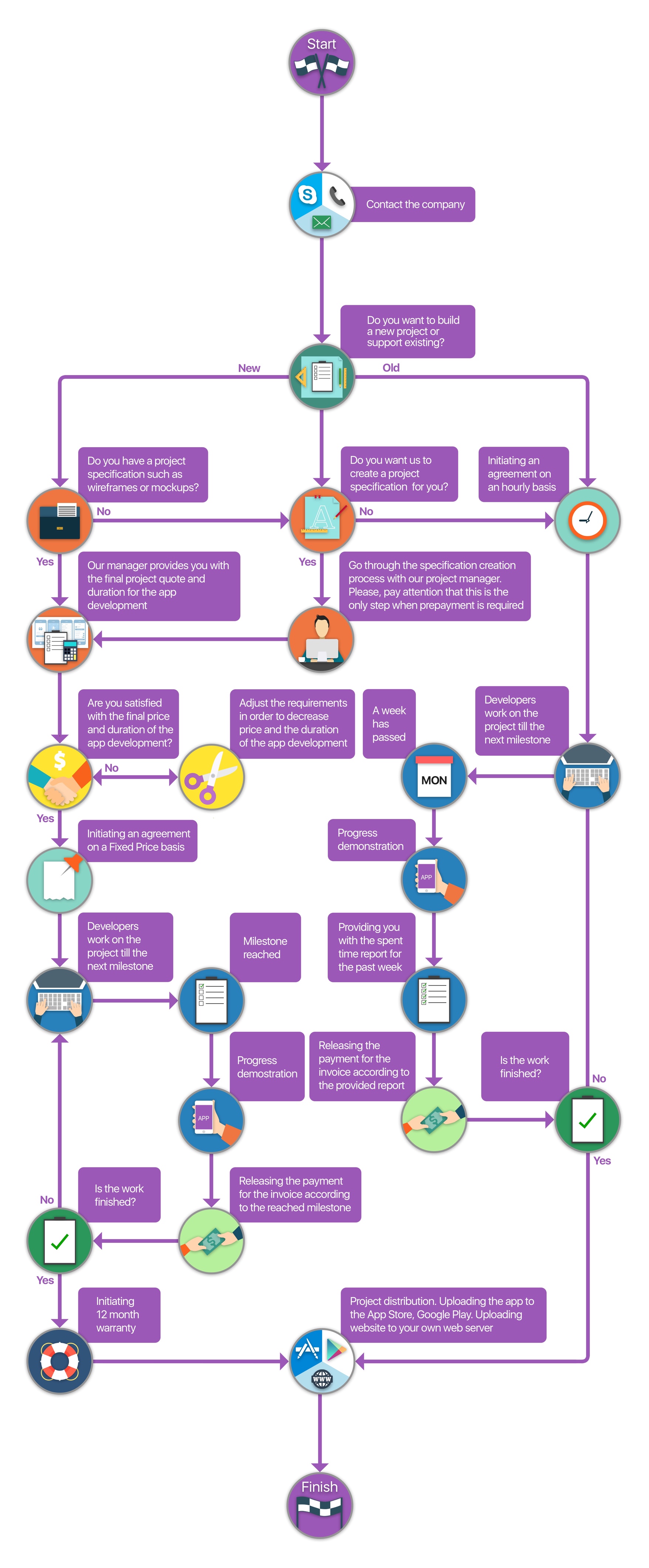By: Dmitry Mi.
3 JUL 2017
8452
Many people don’t know what to expect when they collaborate with IT firms on their first project, and as a result, they are afraid to take that first step. To clear up any questions you may have that are causing these fears, I’ll explain what to expect when you order an app or a website development services so that there will be no surprises for you.
This info-graphic demonstrates the process of app development from start to finish:
App development life cycle
Now, allow me to go into detail about each step of the app development life cycle.
Step 1
Let’s say you have decided to develop a mobile app or a website. The first thing you need to do is contact the company you have chosen and request their software development services. It’s as simple as that.
Step 2
The next step is little bit more difficult: You will need to clarify your requirements. This is where we first branch off. All IT jobs can be divided into two types: support of an existing project and building a new project from scratch. The approach for each type is different, so it’s likely it will be one of the first things the manager will ask you. If your need is support of an existing project, then please proceed to step #5 right away with one last point—the agreement will have an hourly rate basis.
Step 3
Let’s assume you want to build a new app or a website. The next question that manager will ask you is “Do you have a project specification?” Project specification is similar to a construction plan for a house. Even if you wish to build a small house, like a barn or a pole building, you still need at least some specifications, such as width, height, position, etc. It’s similar when building a mobile app or a website. It’s important to understand that project specification is absolutely necessary, because without it, the project cannot be evaluated.
And this is where we have another branching off: You either want to create an app specification by yourself (or have already created it) or you want to hand that job over to the company you contacted. Let’s review both options:
1. Let’s assume that you want to create an app specification by yourself. That’s not as complex as it may sound. There is no accredited standard that exists for a project specification. Everyone can do this however he or she likes. The main thing that you need to do is to outline your thoughts on paper (or a digital file) as clearly as possible in order to convey this information to the software developer(s) without any misunderstandings. The best way to do this is to use wireframes (mockups). Draw a picture of your app or website instead or writing pages of instructions. Here are a few mockup drawing tools that can be helpful:
2. Let’s assume you want the company you contacted to create the wireframes for you. This is reliable way of creating wireframes because the manager who will be working on this task will be sure to know what requirements should be met on the project specifications and what can be disregarded as trivial. You will be also involved in the process as the manager will ask you a number of questions and you will need to confirm the final version of wireframes at the end of the process in order to be sure that it matches your vision 100%. Here is an example of how the final wireframes will look like.The process of creating wireframes assumes the work of a manager and UI designer. This work will raise the price of the project and require prepayment. Luckily, in our company, we provide this work on a conditionally free basis. This means that the amount paid for wireframes creation services will be deducted from the development costs.
Step 4
The next step is the evaluation process. Technical specialists will measure the project specifications and, the project manager will provide the price and the length of time required to create the project. If the estimate is too high for your budget, you could reduce your requirements to reduce the price. Or you can try your luck with another contractor and compare estimates.
Step 5
The next step is signing the services contract. The project manager will prepare an agreement and give it to you for your approval and signature. A quick tip: Check that the agreement contains the final version of the project specification. This sounds like a trivial thing, but I have seen many agreements where the “work description” section was only a sentence, such as “Develop mobile app” or something like that. The project specification is an integral part of the agreement.
Step 6
After the agreement is signed, the project begins. If you signed the agreement with a fixed price, the project will continue until the milestone is reached. If you signed the agreement with an hourly basis, the project will continue until the next work week begins. You may read more about the differences between these agreement types here.
Step 7
After the first milestone is reached (or a new work week has begun in the case of an hourly rate agreement), the contractor should report on the work done and demonstrate the achieved results. It could be a link to install a mobile app or a link to a website. This is the step where you should make your first payment, at least at our company. We strongly suggest that you do not pay until you see the real results of the work. Once the payment has been made, the cycle repeats from step #6 until the project is completed.
Step 8
After the project is finished, it’s time to distribute the project. For a mobile app, this means uploading it to the App Store or Google Play; for a website, this means uploading it to a production server. In our company, this step is free of charge. Also, during this step, we initiate a 12-month warranty.
In conclusion
That’s all there is to it. I tried to be as brief as possible, and I hope my explanation shed some light on the development process. Thanks for reading, and I wish you the best of luck with your project.
 Services
Services
 Work
Work
 Company
Company
 Blog
Blog
 Contact
Contact



